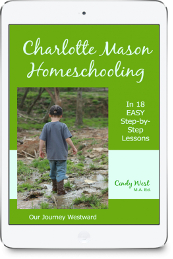There are many resources and websites for learning about Charlotte Mason’s educational approach. But Charlotte Mason Homeschooling In 18 Easy Step-by-Step Lessons caught my attention because author Cindy West has a gradual plan for implementing it that should work for even the most insecure parent or teacher. West concludes each of the 18 chapters of this book with homework for the parent or teacher. That homework is either for reflection time and self-assessment or for actual implementation. For example, Chapter 2 introduces the idea of living books and has this homework assignment:
Start slowly. Choose one subject your child is currently studying. Take a look at the reading material that goes along with the lesson(s). Is it living (interesting, meaningful, engaging?) If so, way to go! Move on to another subject and see how the reading material stacks up.If not, why not try replacing the lesson text with a living book from the library instead? Use one of the online lists above for ideas.
West adds to this homework another paragraph addressing a common concern about how to assess learning. Each homework assignment, like the one above, has you try one manageable implementation so that you can gradually transition into a Charlotte Mason style of education. West says to read and do the homework for only one chapter each week, which means it will take a semester to get through this 80-page book. I suspect many parents will want to speed up the process, covering two or more chapters per week, but there’s no need to rush, and perhaps a good reason to take it slowly.
This approach helps parents experiment bit by bit with learning methods that might be very different than anything they’ve experienced. This slow but steady transition seems a much better way to go in most situations. It should make a smoother transition for both parent and child rather than if you were to try to implement Charlotte Mason's methods all at once.
West begins the book by explaining the essence of the Charlotte Mason approach in the first few chapters. Next, she simply and clearly explains narration, copywork, and dictation, some of the hallmarks of Mason’s methodology that are the most challenging for newcomers to Charlotte Mason methodology to understand. Then West walks us through the different subject areas, presenting both Mason’s ideas and her own suggestions for the practical implementation of those ideas in the modern homeschool.
Most of the remaining chapters cover subject areas under the headings of language arts, math, nature study, science, history and geography, foreign language, artist study, composer and hymn study, and Bible study. There is also an entire chapter explaining how to teach poetry and Shakespeare, and another chapter on handicrafts and life skills.
The last two chapters of the book step outside academic subjects to address two critical issues: habit training and scheduling. The chapter on habit training serves as a short course on parenting. West quotes Charlotte Mason on page 73 regarding the importance of helping children form good habits: “The mother who takes pains to endow her children with good habits secures for herself smooth and easy days; while she who lets their habits take care of themselves has a weary life of endless friction with the children.” West doesn’t say this, but if you are thinking of implementing Charlotte Mason's methodology, and your children are out of control, you might want to jump ahead to this chapter before starting to read about academics.
In Chapter 18, West explains what her family’s daily schedule looks like, but this is only for reference rather than a template for others to follow. Homework for the final chapter is to write down your own version of your "dream" Charlotte Mason style schedule, and then compare it with your current schedule. West is confident that her readers will find the Charlotte Mason schedule more manageable and appealing for their families.
Charlotte Mason Homeschooling In 18 Easy Step-by-Step Lessons packs an amazing amount of information into a relatively short book. It is available only as a PDF, and that format allows West to include helpful links to websites and resources, adding value to the book. While some of these links are to other Charlotte Mason resources that West sells, many are to free resources such as her lengthy list of geography-related picture books, lists of her own favorite living books for the different historical periods, and resources at other sites such as AmblesideOnline and Living Books Curriculum.








